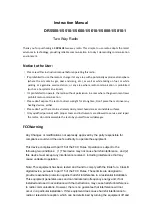
on, the user is encouraged to try to correct the interference by one or more of the
following measures:
—Reorient or relocate the receiving antenna.
—Increase the separation between the equipment and receiver .
—Connect the equipment into an outlet on a circuit different from that to which the
receiver is connected .
—Consult the dealer or an experienced radio / TV technician for help.
Warning:
NOTICE: This radio is intended for use in occupational/controlled conditions where users
have full knowledge of their exposure and can exercise control over their exposure to
meet the occupational limits in FCC/ISEDC and International standards. This radio device
is not authorized for general population consumer use.
RF Exposure Requirements:
To control your exposure and ensure compliance with the occupational/controlled
environmental exposure limits, always adhere to the following procedures.
Guidelines:
Do not remove the RF Exposure Label from the device.
User awareness instructions should accompany device when transferred to other
users.
Do not use this device if the operational requirements described herein are not met.
Operating Instructions:
Transmit no more than the rated duty factor of 50% of the time. To transmit (talk), push
the Push-To-Talk (PTT) key. To receive calls, release the PTT key. Transmitting 50% of
the time, or less, is important because the radio generates measurable RF energy only
when transmitting (in terms of measuring for standards compliance).
Keep the radio unit at least 2.5 cm away from the face. Keeping the radio at the proper
distance is important as RF exposure decreases with distance from the antenna. The
antenna should be kept away from the face and eyes.
When worn on the body, always place the radio in a COVALUE approved holder,
holster, case, or body harness or by use of the correct clip for this product. Use of
non-approved accessories may result in exposure levels which exceed the FCC's
occupational/controlled environmental RF exposure limits.





























